Abstract
Pneumococcal opsonic activity and concentrations of pneumococcal capsular polysaccharide antigen, C3, C4 factor B, C3 and factor B breakdown products were measured in the serum obtained acutely from 12 patients with serious pneumococcal disease. One patient showed markedly reduced pneumococcal opsonic activity, borderline-low C3, and the presence of C3 and factor B breakdown products and died. Although eight additional patients showed depressed levels of C3 or C4 or the presence of C3 or factor B breakdown products, none had reduced pneumococcal opsonic activity. All of the three remaining patients had normal opsonic activity and C3 and C4 levels. Covalescent serum was obtained from eight patients; six had normal C3 and C4 levels, and two had persistent C4 depression. These data show that complement is activated during pneumococcal disease and suggest that extensive complement activation may impair pneumococcal opsonic activity in certain patients and thereby compromise an important host defense mechanism.
Full text
PDF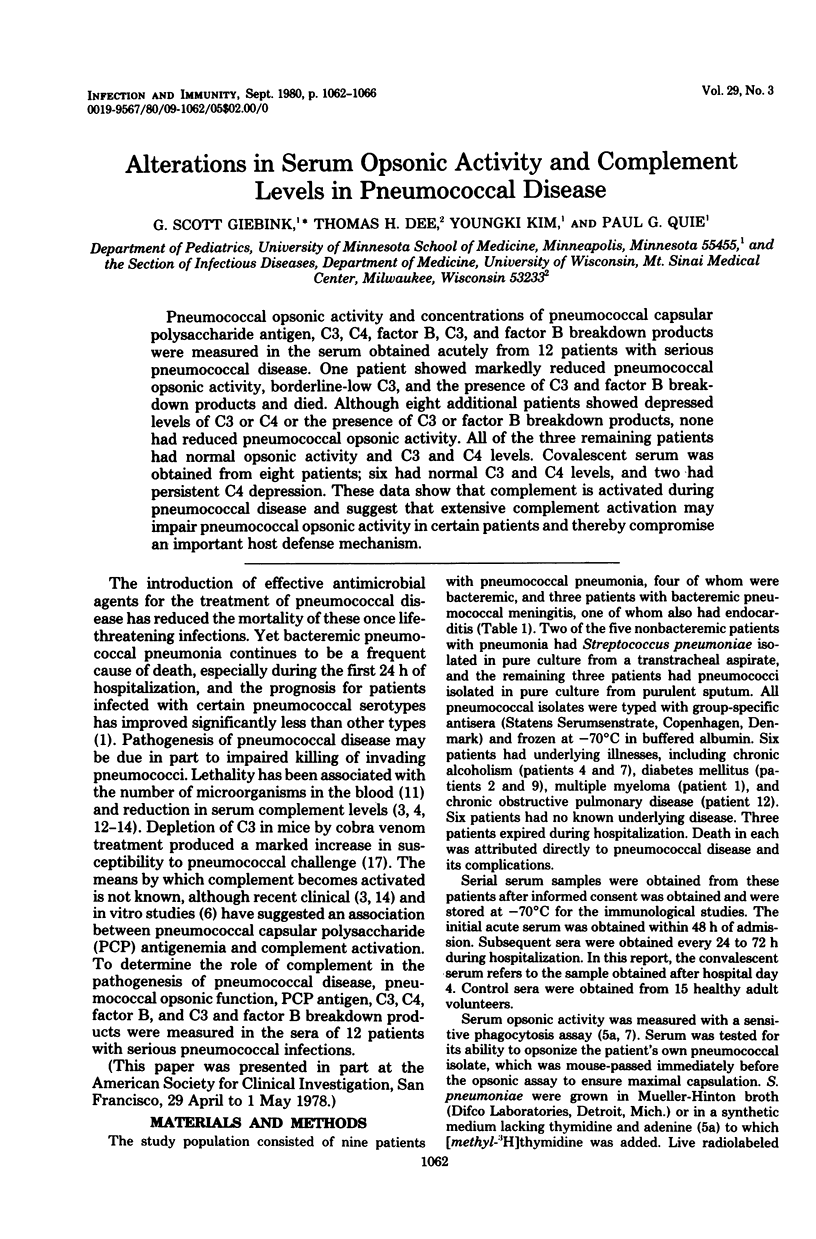
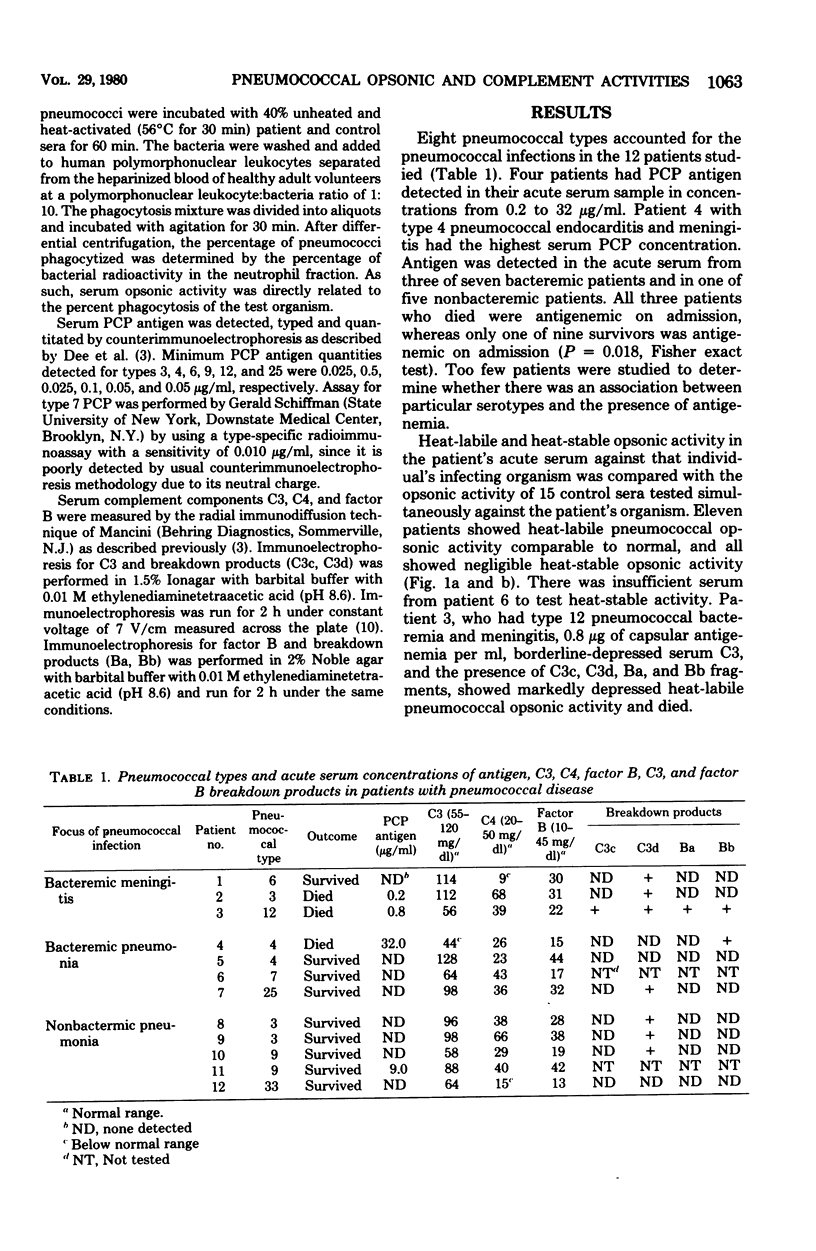
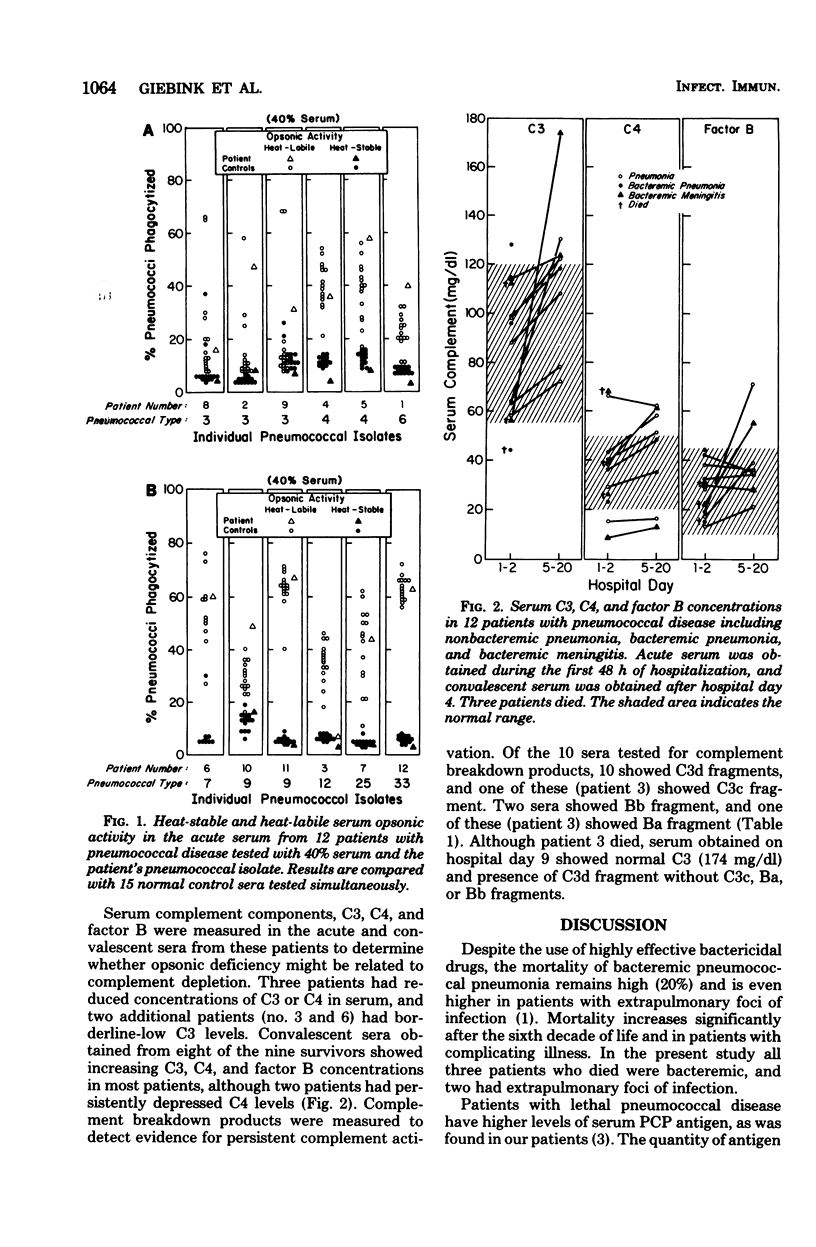
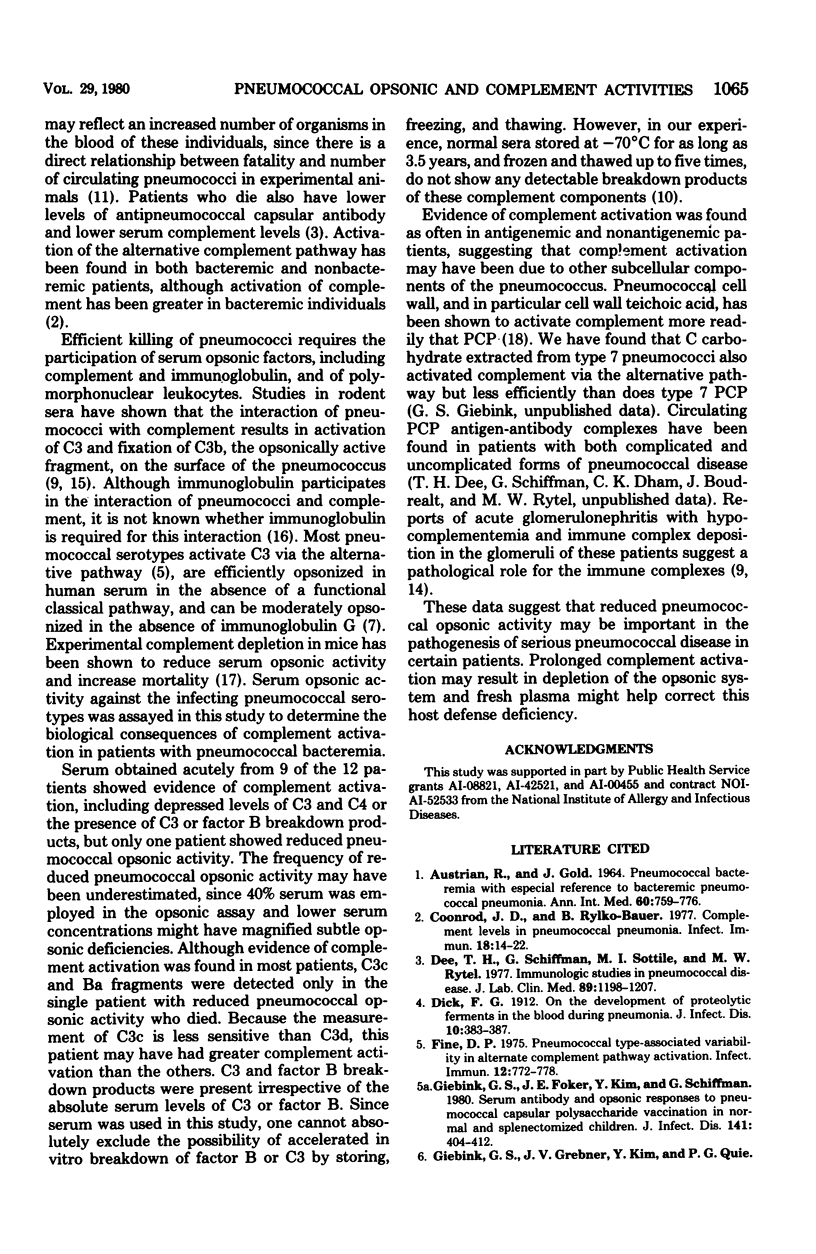
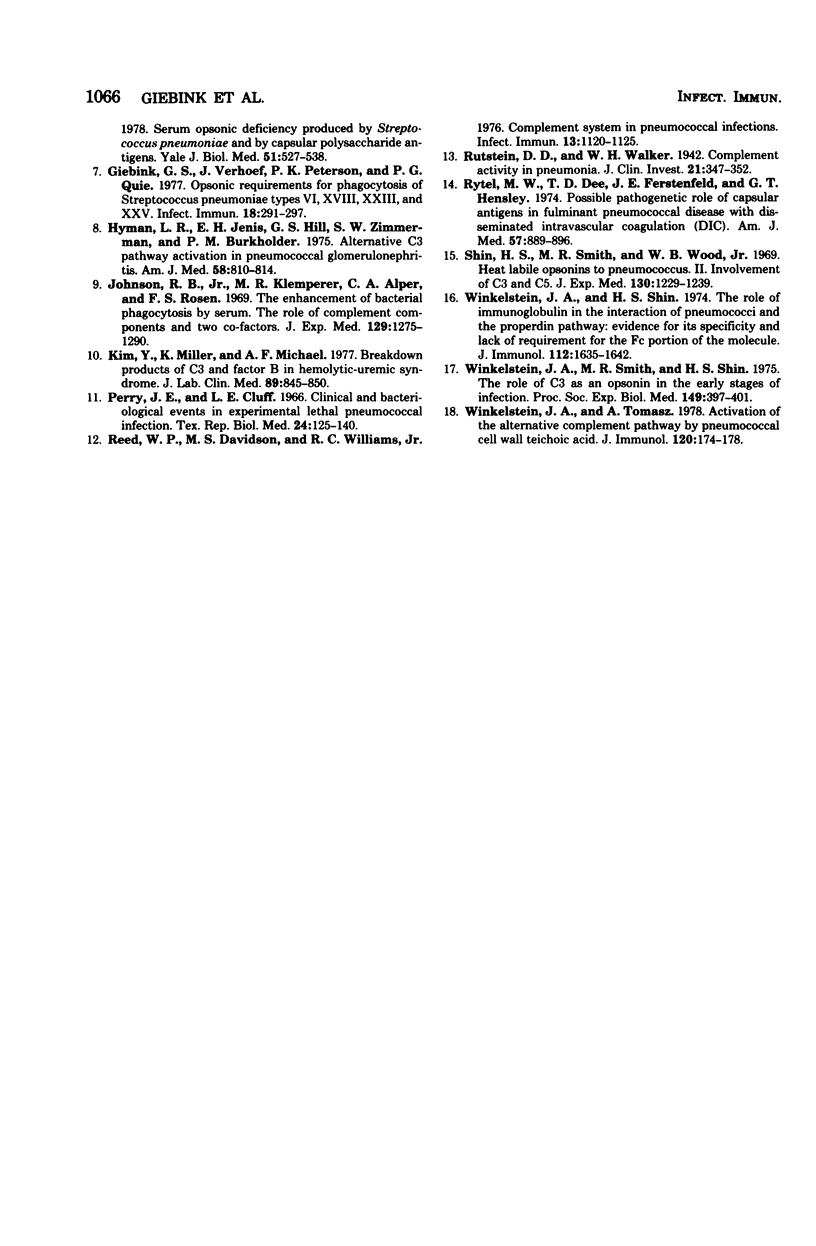
Selected References
These references are in PubMed. This may not be the complete list of references from this article.
- AUSTRIAN R., GOLD J. PNEUMOCOCCAL BACTEREMIA WITH ESPECIAL REFERENCE TO BACTEREMIC PNEUMOCOCCAL PNEUMONIA. Ann Intern Med. 1964 May;60:759–776. doi: 10.7326/0003-4819-60-5-759. [DOI] [PubMed] [Google Scholar]
- Coonrod J. D., Rylko-Bauer B. Complement levels in pneumococcal pneumonia. Infect Immun. 1977 Oct;18(1):14–22. doi: 10.1128/iai.18.1.14-22.1977. [DOI] [PMC free article] [PubMed] [Google Scholar]
- Dee T. H., Schiffman G., Sottile M. I., Rytel M. W. Immunologic studies in pneumococcal disease. J Lab Clin Med. 1977 Jun;89(6):1198–1207. [PubMed] [Google Scholar]
- Fine D. P. Pneumococcal type-associated variability in alternate complement pathway activation. Infect Immun. 1975 Oct;12(4):772–778. doi: 10.1128/iai.12.4.772-778.1975. [DOI] [PMC free article] [PubMed] [Google Scholar]
- Giebink G. S., Foker J. E., Kim Y., Schiffman G. Serum antibody and opsonic responses to vaccination with pneumococcal capsular polysaccharide in normal and splenectomized children. J Infect Dis. 1980 Mar;141(3):404–412. doi: 10.1093/infdis/141.3.404. [DOI] [PubMed] [Google Scholar]
- Giebink G. S., Verhoef J., Peterson P. K., Quie P. G. Opsonic requirements for phagocytosis of Streptococcus pneumoniae types VI, XVIII, XXIII, and XXV. Infect Immun. 1977 Nov;18(2):291–297. doi: 10.1128/iai.18.2.291-297.1977. [DOI] [PMC free article] [PubMed] [Google Scholar]
- Hyman L. R., Jenis E. H., Hill G. S., Zimmerman S. W., Burkholder P. M. Alternative C3 pathway activiation in pneumococcal glomerulonephritis. Am J Med. 1975 Jun;58(6):810–814. doi: 10.1016/0002-9343(75)90636-1. [DOI] [PubMed] [Google Scholar]
- Johnston R. B., Jr, Klemperer M. R., Alper C. A., Rosen F. S. The enhancement of bacterial phagocytosis by serum. The role of complement components and two cofactors. J Exp Med. 1969 Jun 1;129(6):1275–1290. doi: 10.1084/jem.129.6.1275. [DOI] [PMC free article] [PubMed] [Google Scholar]
- Kim Y., Miller K., Michael A. F. Breakdown products of C3 and factor B in hemolytic-uremic syndrome. J Lab Clin Med. 1977 Apr;89(4):845–850. [PubMed] [Google Scholar]
- Perry J. E., Cluff L. E. Clinical and bacteriological events in experimental lethal pneumococcal infection. Tex Rep Biol Med. 1966 Spring;24(1):125–140. [PubMed] [Google Scholar]
- Reed W. P., Davidson M. S., Williams R. C., Jr Complement system in pneumococcal infections. Infect Immun. 1976 Apr;13(4):1120–1125. doi: 10.1128/iai.13.4.1120-1125.1976. [DOI] [PMC free article] [PubMed] [Google Scholar]
- Rutstein D. D., Walker W. H. COMPLEMENT ACTIVITY IN PNEUMONIA. J Clin Invest. 1942 May;21(3):347–352. doi: 10.1172/JCI101308. [DOI] [PMC free article] [PubMed] [Google Scholar]
- Rytel M. W., Dee T. H., Ferstenfeld J. E., Hensley G. T. Possible pathogenetic role of capsular antigens in fulminant pneumococcal disease with disseminated intravascular coagulation (DIC). Am J Med. 1974 Dec;57(6):889–896. doi: 10.1016/0002-9343(74)90166-1. [DOI] [PubMed] [Google Scholar]
- Shin H. S., Smith M. R., Wood W. B., Jr Heat labile opsonins to pneumococcus. II. Involvement of C3 and C5. J Exp Med. 1969 Dec 1;130(6):1229–1241. doi: 10.1084/jem.130.6.1229. [DOI] [PMC free article] [PubMed] [Google Scholar]
- Winkelstein J. A., Shin H. S. The role of immunoglobulin in the interaction of pneumococci and the properdin pathway: evidence for its specificity and lack of requirement for the Fc portion of the molecule. J Immunol. 1974 May;112(5):1635–1642. [PubMed] [Google Scholar]
- Winkelstein J. A., Smith M. R., Shin H. S. The role of C3 as an opsonin in the early stages of infection. Proc Soc Exp Biol Med. 1975 Jun;149(2):397–401. doi: 10.3181/00379727-149-38815. [DOI] [PubMed] [Google Scholar]
- Winkelstein J. A., Tomasz A. Activation of the alternative complement pathway by pneumococcal cell wall teichoic acid. J Immunol. 1978 Jan;120(1):174–178. [PubMed] [Google Scholar]


